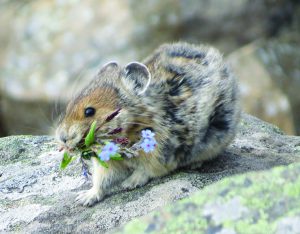BY HANNES THUM
 We humans have invented all sorts of implements for making hay. Farmers drive combines, swathers, and windrowers. They swing scythes and hay rakes. They harvest, condition, and stack—all to produce a simple product: dried grasses for animals to eat.
We humans have invented all sorts of implements for making hay. Farmers drive combines, swathers, and windrowers. They swing scythes and hay rakes. They harvest, condition, and stack—all to produce a simple product: dried grasses for animals to eat.
But, one of the greatest hay-makers around is a small creature that lives high up in our local mountains: the American pika (Ochotona princeps). Close cousins to rabbits, our local pikas are unique critters that live in high scree slopes throughout the Rockies, at the very edge of a survivable altitude for mammals. One of their most notable attributes is the way that they spend most of their summers harvesting and stacking hay in piles within the scree (biologists actually call the piles “haystacks”), and most of the winter burrowed comfortably under the snow, eating the hay.
You’ll usually hear a pika before you see one. The noise they make is surprisingly hard to describe with words on paper, but I’ll try: it sounds like a CHEEP or a BEEP or a MEEP.
In the scree and talus fields where these critters live, they are constantly on the move in late summer and autumn. A hillside can come alive with pikas if you sit long enough to spot them. The easiest way is to sit at the bottom of a scree slope, binoculars in hand, and just wait. If they are there, you’ll hear them. If you wait long enough, you’ll see them—hopping from stone to stone, ducking beneath the rocks for cover, down out of sight in a tunnel one moment and then back up to the pointed top of an outcropping to survey their surroundings the next, looking for vegetation to cut and pile into their hidden haystacks.
The title of “toughest species” is something that comes up quite a bit in my world. My students often wonder about the concept, especially when it comes to surviving winter. Wolverines are a popular choice. So are wolves, elk, and ermine. But, we would be remiss to not consider the pika as one of the top contenders for toughness.
Reason number one: they are tiny and thus very vulnerable to cold (small critters, by the nature of geometry, lose body heat exponentially faster).
Reason number two: they maintain high metabolic rates throughout the entire winter (unlike some of the “cheaters” in the animal kingdom who escape winter by slowing down their body systems to make it through in a coma-like state).
And, reason number three: they survive winter with a kind of classy demeanor that tempts me to anthropomorphize them, even though I know I shouldn’t. I picture them spending the winter, kicked back in comfort with that chubby-cheeked smile intact on their faces, unperturbed by the storms that rage around them—calmly, serenely chewing on their hay while they wait for springtime.
Hannes Thum is a Wood River Valley native and has spent most of his life exploring what our local ecosystems have to offer. He currently teaches science at Sun Valley Community School.


